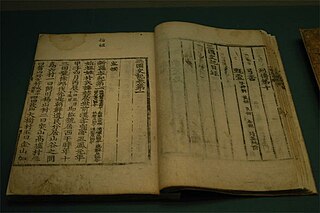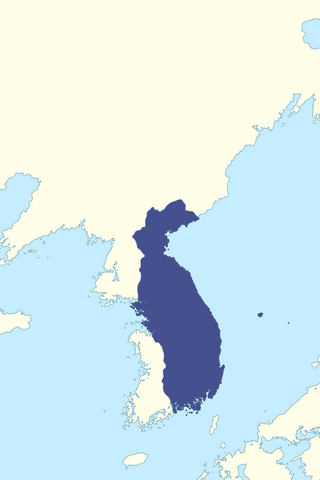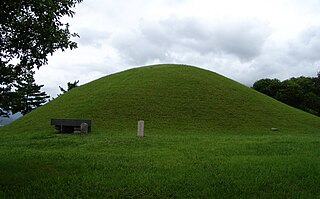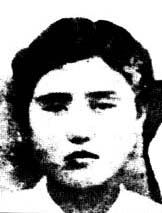Related Research Articles

Samguk Sagi is a historical record of the Three Kingdoms of Korea: Goguryeo, Baekje and Silla. Completed in 1145, it is well known in Korea as the oldest surviving chronicle of Korean history.

Baekje or Paekche was a Korean kingdom located in southwestern Korea from 18 BC to 660 AD. It was one of the Three Kingdoms of Korea, together with Goguryeo and Silla. While the three kingdoms were in separate existence, Baekje had the highest population of approximately 3,800,000 people, which was similar to that of Goguryeo and much larger than that of Silla.

The Three Kingdoms of Korea or Samhan competed for hegemony over the Korean Peninsula during the ancient period of Korean history. During the Three Kingdoms period, many states and statelets consolidated until, after Buyeo was annexed in 494 and Gaya was annexed in 562, only three remained on the Korean Peninsula: Goguryeo, Baekje and Silla. The "Korean Three Kingdoms" contributed to what would become Korea; and the Goguryeo, Baekje and Silla peoples became the Korean people.

Silla, alternatively Shilla, was a Korean kingdom that existed between 57 BCE – 935 CE and located on the southern and central parts of the Korean Peninsula. Silla, along with Baekje and Goguryeo, formed the Three Kingdoms of Korea. Silla had the lowest population of approximately 850,000 people, which was significantly smaller than those of Baekje and Goguryeo.

Kim Yu-sin was a Korean military general and politician in 7th-century Silla. He led the unification of the Korean Peninsula by Silla under the reign of King Muyeol and King Munmu. He is said to have been the great-grandchild of King Guhae of Geumgwan Gaya, the last ruler of the Geumgwan Gaya state. This would have given him a very high position in the Silla bone rank system, which governed the political and military status that a person could attain.

Seong of Baekje was the 26th king of Baekje, one of the Three Kingdoms of Korea. He was a son of Muryeong of Baekje and is best known for making Buddhism the state religion, moving the national capital to Sabi, and reclaiming the center of the Korean Peninsula. His demise eventually came at the hands of an ally who betrayed him. The name Seong translates as 'The Holy.'

Hubaekje or Later Baekje was one of the Later Three Kingdoms of Korea, along with Taebong and Silla. Later Baekje was a Korean dynastic kingdom founded by the disaffected Silla general Kyon Hwon in 900, whom led the local gentry and populace that were in large Baekje descent holding onto their collective consciousness until the twilight days of Later Silla. With the former Silla general declaring the revival of the Baekje kingdom of old, the Baekje refugees from the old territories and a portion of the Rank Six Nobility from Silla seeking the opportunity of rising up the ranks gathered under his leadership. Led by the charismatic and capable Kyon Hwon who was also a competent field commander, Later Baekje in its early days was advantageous in the power game against the newly found kingdom Goryeo and the declining Silla. However, despite its fertile territories in the Jeolla Province and capable military prowess, it eventually fell to Wang Kon's Goryeo army in 936 due to political strife and Kyon Hwon's defection towards Goryeo. Its capital was at Jeonju, in present-day North Jeolla province.
Kyŏn Hwŏn was the king and founder of Later Baekje, one of the Later Three Kingdoms of Korea, and reigned from 892 to 935. Some records render his name as Chin Hwŏn. He was also the progenitor of the Hwanggan Kyon clan. Substantial accounts of his life are preserved in the Samguk sagi, which presents a single narrative, and the Samguk yusa, which presents excerpts about him from various sources.

Korea's military history spans thousands of years, beginning with the ancient nation of Gojoseon and continuing into the present day with the countries of North Korea and South Korea, and is notable for its many successful triumphs over invaders.

Jinpyeong was the 26th king of the Silla dynasty, one of the Three Kingdoms of Korea. King Jinpyeong followed in the footsteps of his predecessor, King Jinji, by reorganizing the central ruling system of Silla. Upon the onset of a multitude of conflicts between Baekje and Goguryeo, he sent emissaries to improve relations and strengthen ties between Silla and the Chinese dynasties Sui and Tang. He is also known for his promotion of Buddhism as a spiritual guide for the kingdom and encouraging Buddhist teachings.

Kim Myeong-sun was a female Korean novelist and poet of the early 20th century. She wrote under the art names Tansil and Mangyangcho.
Kim Myeong-sik was a Korean independence activist and writer during the period of Japanese occupation. He joined the editorial committee of the Donga Ilbo in 1920. In the same year, he formed the Korean Workers' League (노동공제회) with others including Pak Jung-hwa and Jang Deok-su and published the league magazine Gongje. In 1922, he was arrested and imprisoned for two years by the Japanese government, due to his involvement with the magazine New Life (신생활) which was managed by Pak Hui-do.
Gim Myeong-yun, also known as Kim Myeong-yun, was a scholar-official of the Joseon Dynasty who was involved in the Eulsa purge of 1545. The Eulsa purge took place following the accession of Myeongjong of Joseon, which brought a new in-law family to power. He was serving as the governor of Gyeonggi province when Yun Won-hyeong began to kill his enemies in the government, including Minister of Punishments Yun Im as well as Minister of Personnel Yu In-suk. Gim told Yun that Prince Gyerim and Prince Bongseong had been aware of the plots of these ministers, and thus brought about the death of Prince Gyerim.
Gim Myeong-hui (1788-?), also known as Kim Myeong-hui, was a calligrapher of the late Joseon Dynasty. He was born into a yangban family of the Gyeongju Gim lineage, the son of Gim No-gyeong. He passed the jinsa literary examination in 1810, and entered government service. However, he never rose above the rank of hyeon magistrate. Accompanying his father on a mission to the Qing Dynasty court in 1822, he struck up correspondences with leading Chinese calligraphers of the time, including Liu Xihai.
Kim Mu-ch'e was a scholar and educator under the Goryeo Dynasty, and founder of one of the Twelve Assemblies of Goryeo. He passed the literary examination in 1035, and rose to a position of rank. Under the reign of Munjong, Kim opened a private academy called Seowondo, which became one of the leading educational institutions of the kingdom. This and the other Twelve Assemblies came to be preferred over the national academy.
Gim Myeong-won, was a high official of the Korean state Joseon, who served King Seonjo during the 1592–1598 Japanese invasions of Korea.

The Goguryeo–Tang War occurred from 645 to 668 and was fought between Goguryeo and the Tang dynasty. During the course of the war, the two sides allied with various other states. Goguryeo successfully repulsed the invading Tang armies during the first Tang invasions of 645–648. After conquering Baekje in 660, Tang and Silla armies invaded Goguryeo from the north and south in 661, but were forced to withdraw in 662. In 666, Yeon Gaesomun died and Goguryeo became plagued by violent dissension, numerous defections, and widespread demoralization. The Tang–Silla alliance mounted a fresh invasion in the following year, aided by the defector Yeon Namsaeng. In late 668, exhausted from numerous military attacks and suffering from internal political chaos, Goguryeo and the remnants of Baekje army succumbed to the numerically superior armies of the Tang dynasty and Silla.

The Silla–Tang War (670–676) occurred between the Silla kingdom of Korea and the Tang dynasty of China. It began in the geopolitical context immediately following the conquest of Goguryeo and Baekje by the joint forces of Silla and Tang. The conflict ended with a truce between Tang and Silla due to the internal political situation in both states, with the dividing territorial line at the Taedong River basin.

The Baekje–Tang War was fought between Baekje and the allied forces of the Tang dynasty and Silla between 660 and 663. The war was caused by the ongoing Goguryeo–Tang War in which numerous attacks and raids were made by Baekje and Goguryeo against Silla. King Muyeol of Silla sought help from Emperor Gaozong of Tang, who launched the invasion of Baekje in 660. After the conquest of Baekje later that year, loyalist forces from Baekje with the aid of Yamato allies attempted to resist the occupation of their kingdom until the two allied forces were destroyed in 663.
Heung Su was a politician and Prime Minister of Baekje, one of the Three Kingdoms of Korea. He is remembered for giving advice to the last king of Baekje, Uija of Baekje but was exiled for this. Many believe his advice would have saved the kingdom.